Zumo Robot Kit for Arduino, v1.2 (No Motors)
Retired Product
Replaced by: POLOLU-3124This product is no longer available. This page is only for reference.
Note: This product is a kit; assembly (including soldering) is required. Motors, batteries, and Arduino are sold separately. An assembled version is available that does not require any assembly or soldering and includes motors and a Zumo reflectance sensor array.
New inertial sensors! In September 2020, Pololu started transitioning to shipping this kit with the v1.3 version of the Zumo Shield. The main difference is the new version replaces the shield’s inertial sensors with an LSM6DS33 accelerometer and gyro and an LIS3MDL magnetometer, as the LSM303D accelerometer and magnetometer used on the original revision has been discontinued. You can use Pololu's updated Zumo Shield Arduino library to help you write code that will work with the inertial sensors on either revision. In addition, the power switch and pushbuttons on the v1.3 shield have been changed to be surface-mount parts. For more information, see the user’s guide.All units shipping now from Pololu have the newer v1.3 shield. If you require units with the previous v1.2 version, please contact us before you place your order.
Kit Contents
- One Zumo Shield for Arduino
- One Zumo chassis kit
- One Zumo blade
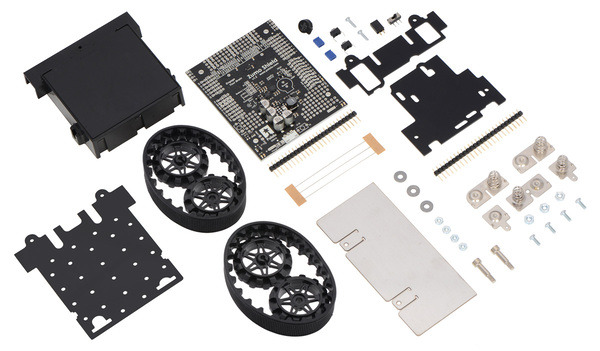 |
Contents of the Zumo robot kit for Arduino, v1.2. |
|---|
Please see the specific pages for those products for more information about them, assembly instructions, and links to related resources.
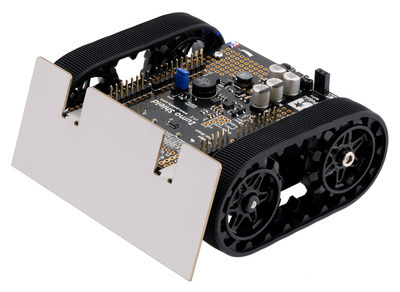 |
Zumo Robot for Arduino, v1.2. |
|---|
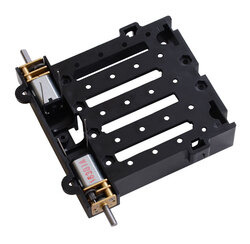 |
Zumo chassis being assembled with two micro metal gearmotors. |
|---|
Required Accessories (not included)
- Two micro metal gearmotors. These gearmotors are available in several power options and a wide variety of gear ratios, allowing for a customizable combination of torque and speed. The Zumo Shield can deliver enough power for all of the micro metal gearmotors Pololu carry, including the high-power (HP) versions. Note that some gear ratios are better suited for the Zumo than others; please see the Zumo chassis kit product page for specific motor suggestions.
- Four AA batteries. The Zumo chassis works with both alkaline and NiMH batteries, though Pololu recommend rechargeable NiMH cells.
- An Arduino or compatible control board. The Zumo Shield works with the A-Star 32U4 Prime, Arduino Uno and Arduino Leonardo. It is not compatible with the Arduino Mega or Due, but it can be used with older Arduinos that have the same form factor as the Uno, such as the Duemilanove. (Other Arduino-compatible controllers might work with the Zumo robot, but support for them will be limited and they might require modification; for example, one customer got his Zumo robot working with the Freescale FRDM-KL25Z board.)
Optional Accessories
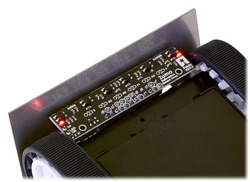 |
Zumo reflectance sensor array on a Zumo robot, bottom view. |
|---|
- Zumo reflectance sensor array. This sensor bar mounts along the front edge of the Zumo shield and allows the Zumo to detect features on the ground in front of it, such as lines for following or edges for avoiding (such as the rim of a sumo ring or the edge of a table). It is designed specifically for use with the Zumo shield.
- iMAX-B6AC battery charger for charging the Zumo’s battery’s through the Zumo Shield’s 2-pin charge port. Note that you only need a battery charger if you plan on powering the Zumo with rechargeable cells, and that charger should be capable of charging 4 NiMH cells in series. Alternatively, since the Zumo just uses ordinary AA batteries, you can use AA chargers (into which you stick the individual cells) available at most general electronics stores.
- Optical rangefinders for obstacle/opponent detection.
- Connectors (headers, jumper wires, etc) for adding more sensors.
- Replacement sprockets in red or white. The Zumo robot for Arduino includes the black sprockets shown in the left picture below, but other colors can be purchased separately if you want to add a bit of personalization to your robot. The following pictures show the newer Zumo 32U4 Robot, which is based on the same Zumo chassis and therefore uses the same sprockets:
|
|
|
Comparison with the Zumo 32U4 robot
The newer Zumo 32U4 is another robot based on the Zumo chassis. It is a more highly integrated robot than the Zumo robot for Arduino, with enhancements that include a built-in Arduino-compatible ATmega32U4 microcontroller (the same one used in the Arduino Leonardo and A-Star 32U4 boards), an LCD, encoders for closed-loop motor control, and proximity sensors for obstacle detection. The Zumo 32U4 main board effectively combines the functions of the Zumo Shield and the separate Arduino controller into a single, compact board that is just as easy to program as a standard Arduino or A-Star thanks to its USB interface and preloaded Arduino-compatible bootloader.
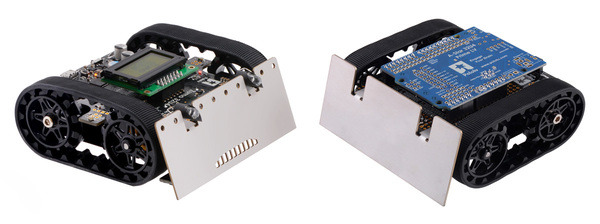 |
A Zumo 32U4 robot (left) and a Zumo robot for Arduino with an A-Star 32U4 Prime LV (right). |
|---|
Some of the pin mappings and software libraries differ between the Zumo 32U4 and Zumo robot for Arduino, so programs written for one robot generally need to be modified to work on the other.
People often buy this product together with:
 | 50:1 Micro Metal Gearmotor HP 6V |
 | Zumo Reflectance Sensor Array |
 | 75:1 Micro Metal Gearmotor HP 6V |
Documentation and other information
-
Pololu Zumo Shield for Arduino User’s Guide (Printable PDF)
User’s manual for the Pololu Zumo Shield for Arduino.
File downloads
-
Schematic diagram of the Zumo Shield for Arduino, v1.3 (183k pdf)
-
Schematic diagram of the Zumo Shield for Arduino, v1.2 (449k pdf)
-
Zumo Shield front expansion pinout (552k pdf)
-
3D model of the assembled Zumo Robot for Arduino (v1.3 Shield) (35MB step)
This model uses simplified models of the control electronics to reduce the file size. More detailed models are available separately of the Zumo shield for arduino, v1.3 (17MB step) and Zumo reflectance sensor array (5MB step).
-
3D model of the assembled Zumo Robot for Arduino (v1.2 Shield) (33MB step)
This model uses simplified models of the control electronics to reduce the file size. More detailed models are available separately of the Zumo shield for arduino, v1.2 (13MB step) and Zumo reflectance sensor array (5MB step).
-
Dimension diagram of the Zumo Shield for Arduino, v1.3 (657k pdf)
-
Dimension diagram of the Zumo Shield for Arduino, v1.2 (467k pdf)
-
3D model of the Zumo Shield for Arduino, v1.3 (17MB step)
-
3D model of the Zumo Shield for Arduino, v1.2 (13MB step)
-
Guide utilisateur du Robot Zumo Pololu (2MB pdf)
Un guide complet pour assembler, utiliser et exploiter rapidement votre Robot Zumo (version 0.1). Note: This French translation of Pololu's Zumo Robot for Arduino user’s guide was made by Pololu's distributor MCHobby.
Recommended links
-
This collection of libraries and examples for the Arduino that make it easy to program an Arduino-controlled robot built with Pololu’s Zumo Shield or Zumo robot kit (also available fully assembled).
-
This is a library for the Arduino that interfaces with Pololu's LSM303D, LSM303DLHC, and LSM303DLM 3D compass and accelerometer carriers as well as the compass and accelerometer ICs on the MinIMU-9 v3 and AltIMU-10 v3 (it also works with older versions of those boards, some of which used the LSM303DLH and LSM303DLHC). It makes it simple to configure the device and read the raw accelerometer and magnetometer data, and it has a function for computing the tilt-compensated heading for those looking to use the LSM303 as a tilt-compensated compass.
-
This is a library for the Arduino that interfaces with Pololu's L3GD20H and L3GD20 3-axis gyro carriers as well as the gyros on the MinIMU-9 v3 and AltIMU-10 v3 (it also works with older versions of those boards, some of which used the L3G4200D and the L3GD20). It makes it simple to configure the device and read the raw gyro data.
-
Simulink Library for Zumo Robot
This library can be used to program an Arduino-controlled Zumo through MATLAB and Simulink. It provides driver blocks for all the sensors present on the Zumo Robot as well as example models showing their usage.
-
How to program a Zumo robot with Simulink
This tutorial on the Adafruit Learning System guides you through the process of programming a Zumo robot with Simulink.
-
Pixy Pet Robot tutorial: adding color vision to the Zumo Robot for Arduino with a Pixy CMUCam-5
This tutorial from Adafruit shows how to pair a Pixy CMUCam-5 vision system with the Zumo Robot for Arduino to enable it to chase objects or follow you around.
-
This article was written by Professor Erich Styger for his class on embedded systems programming at the Lucerne University of Applied Sciences and Arts. It describes various ways to tweak the performance of a Zumo to be more competitive in a Mini Sumo competition. Note that his Zumos use a custom PCB rather than Pololu's Zumo shield for Arduino; Pololu's shield has a lot of capacitance in parallel with the batteries that generally prevents the “battery inertia” problem Erich describes.
-
Using the L3GD20 gyroscope in control systems
This is a YouTube playlist by control systems lecturer Brian Douglas that uses the L3GD20 MEMS gyroscope. It describes the fundamentals of the gyro and how to use it for closed and open loop control projects with MATLAB/Simulink and Arduino.
-
This robot is uses Pololu's Zumo robot kit, 75:1 micro metal gearmotors, and a Zumo reflectance sensor array. Instead of an Arduino it uses a Freescale FRDM-KL25Z as the microcontroller board, and sample code is available for line following and maze solving. By Erich, March 2013.
Exact shipping can be calculated on the view cart page (no login required).
Products that weigh more than 0.5 KG may cost more than what's shown (for example, test equipment, machines, >500mL liquids, etc).
We deliver Australia-wide with these options (depends on the final destination - you can get a quote on the view cart page):
- $3+ for Stamped Mail (typically 10+ business days, not tracked, only available on selected small items)
- $7+ for Standard Post (typically 6+ business days, tracked)
- $11+ for Express Post (typically 2+ business days, tracked)
- Pickup - Free! Only available to customers who live in the Newcastle region (must order online and only pickup after we email to notify you the order is ready). Orders placed after 2PM may not be ready until the following business day.
Non-metro addresses in WA, NT, SA & TAS can take 2+ days in addition to the above information.
Some batteries (such as LiPo) can't be shipped by Air. During checkout, Express Post and International Methods will not be an option if you have that type of battery in your shopping cart.
International Orders - the following rates are for New Zealand and will vary for other countries:
- $12+ for Pack and Track (3+ days, tracked)
- $16+ for Express International (2-5 days, tracked)
If you order lots of gear, the postage amount will increase based on the weight of your order.
Our physical address (here's a PDF which includes other key business details):
40 Aruma Place
Cardiff
NSW, 2285
Australia
Take a look at our customer service page if you have other questions such as "do we do purchase orders" (yes!) or "are prices GST inclusive" (yes they are!). We're here to help - get in touch with us to talk shop.
Have a product question? We're here to help!
Guides
The Maker Revolution
Projects
PiicoDev Ecosystem In Fritzing
10" Home Lab Testing Rack
WLED Hourglass Theatre Prop - DMX Over Wi-Fi!
Makers love reviews as much as you do, please follow this link to review the products you have purchased.

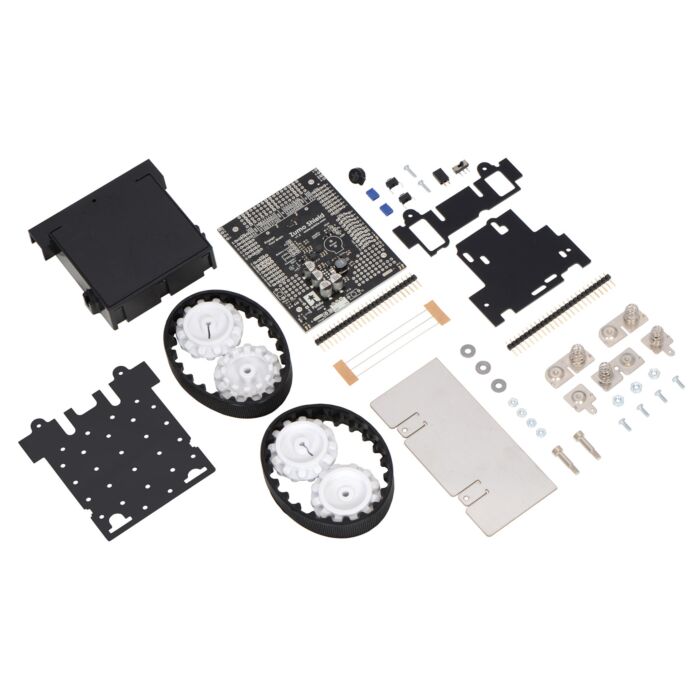

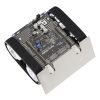
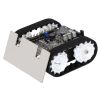
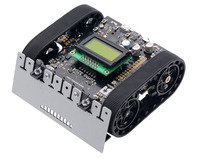
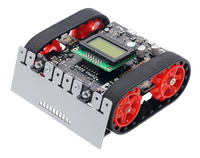
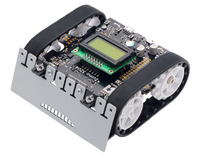


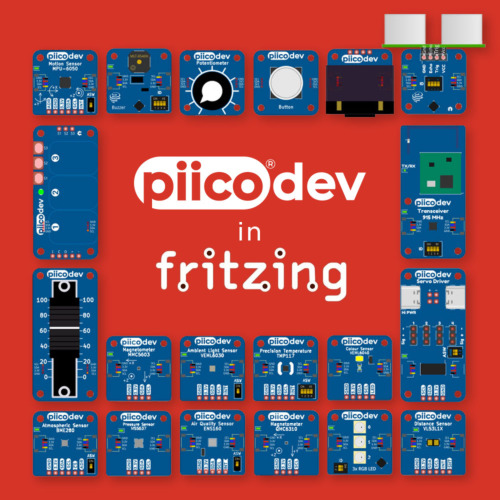



Product Comments